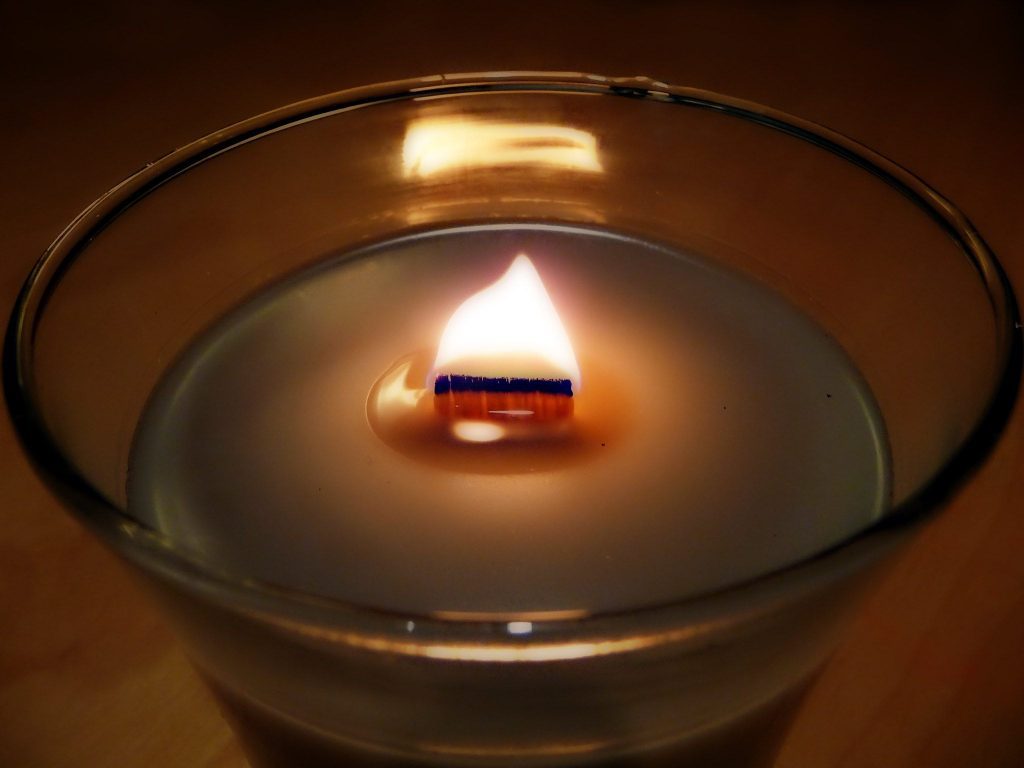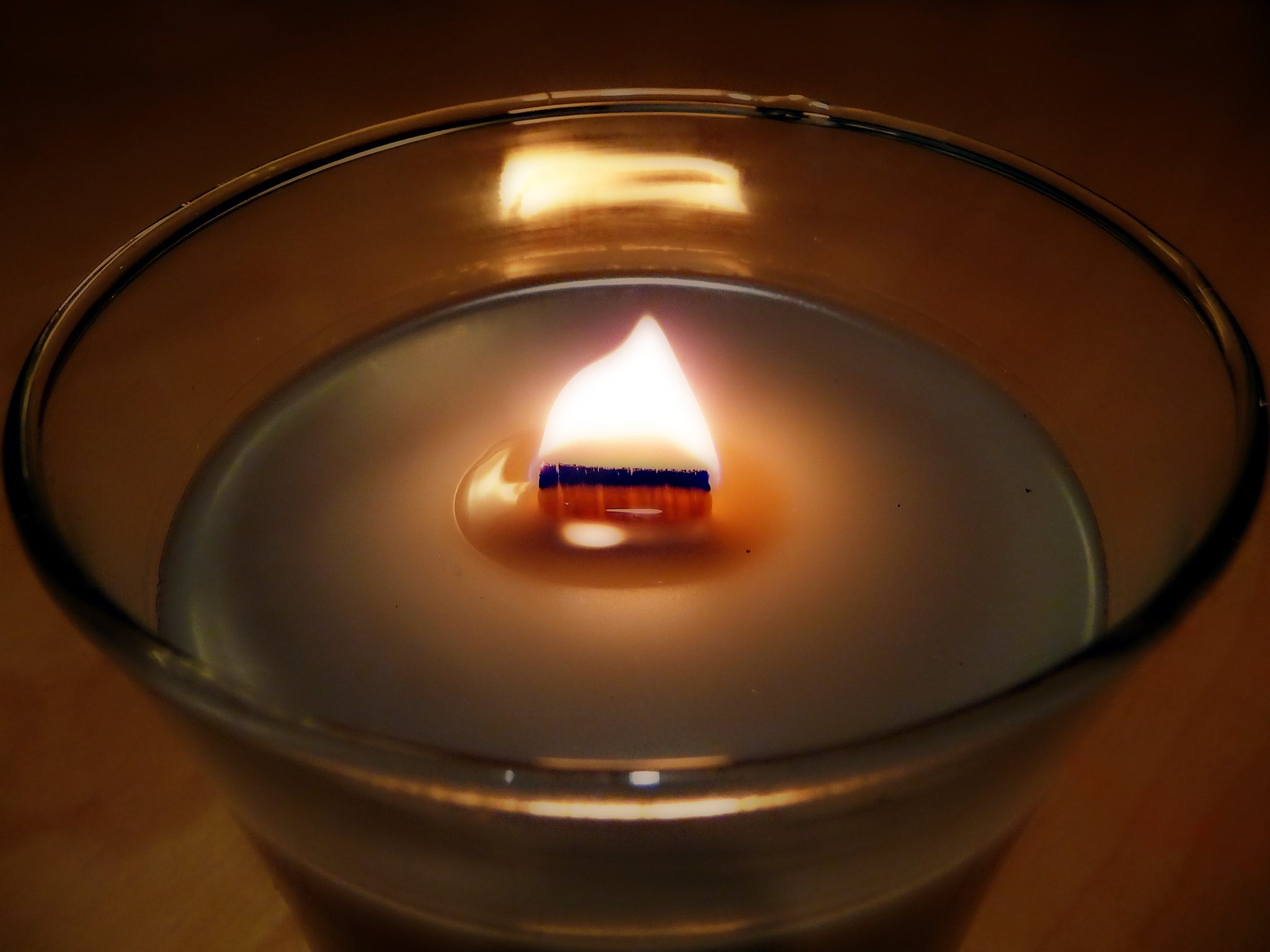Most of the candles sold in stores today are made with a cotton wick, sometimes with paper filaments interlaced in the cotton for a most stable and consistent burn. The paper also helps prevent the wick from curling and becoming lost inside the wax as it solidifies, after the candle is blown out. But cotton is not the only material used for making a wick; almost any absorbent material that the melted wax can wick up via capillary action will work. That makes it possible to use wood as well.
Wood wicks are becoming more popular as an environmentally friendly alternative to cotton wicking. There is even a company that exclusively produces decorative wood wick candles. As they burn, they produce a crackling noise, reminiscent of a fireplace crackling. Wood is also something available for use as an emergency wick in most circumstances. Wood wicks have the advantage of being larger than cotton wicks, which means that they will burn more wax, increasing the heat, light and fragrance produced by the candle.
To understand how this happens, we must first understand how a candle burns. The solid wax is actually unable to burn. That’s why we need the wick. Wicks are always made of flammable material, because the act of lighting the candle is actually lighting that material. As it burns, it immediately starts to melt the wax, which then flows up the wick by capillary action. But the liquid wax doesn’t burn either. Rather, the heat from the candle turns the liquid wax into a hot gas which will react with oxygen in the air, burning. The larger the wick, the more liquid wax that can flow up it at the same time, being gasified and burning.
For wood to work well as a wick, it needs to be dry and porous. Both hardwoods and softwoods can be used, but open pore woods work better, as the open pores provide a ready channel for the liquid wax to flow up. For this reason, oak and ash would work well for candle wicks, but the most common wood that is used is balsa. Balsa also has the dual advantages of being readily available in thin strips and being easy to cut.
Of course, wood is not the only material that can be used to make a candle wick. There are a large variety of other flammable materials that can be used, including newspaper, corrugated cardboard, torn strips of blue jeans, paper towels, toilet paper and twine. The advantage of wood over any of these is its durability and stiffness. A wood wick is unlikely to be damaged or to get caught underneath the wax as it solidifies.
Making a Wood Wick
In order to make a wood candle wick it is essential to start with wood that is already dry. The pores in dry wood provide the necessary channel for the melted wax to flow up. Moisture in the wood fills those pores, blocking the flow of the liquid wax. It would also absorb heat, making it difficult for the candle to light.
Dry wood alone will not work for the wick. It needs to be soaked in something to act as an accelerant. Either oil or wax can be used for this, although oil is probably the better alternative. If scented oil is desired, then olive oil is ideal; but if no scent is desired, perhaps because the scent would interfere with perfumes added to the candle, then mineral oil is ideal.
Making a Candle with a Wood Wick
Once the wicks have been soaked in oil or wax, it’s time to move on to making the candles. This is similar to making any other type of candle in a mold, in that paraffin or soy wax is melted and poured into the vessel, after the wick is put in place.
There are clips and adhesive tabs available for use with wooden wicks. The metal clips attach to the wooden wick and hold it upright in the jar or other vessel being used as a mold or to hold the candle. Small adhesive tabs hold these clips in place, so that the wick doesn’t float as the wax is being poured in.
Always melt whatever wax is being used to make candles in a double boiler to prevent it from becoming hot enough to ignite. Both paraffin and soy wax can be purchased in craft shops or online. Old candles that are no longer usable in their original form can also be melted down, allowing the wax to be recycled into new candles. Colored tabs and candle scents are available, but old crayons work well for coloring candles too, as they are also made of wax. If candle scent is not available, either sweet-smelling spices or essential oils can be used for scent.
Once the candle wax is melted and any coloring agent or scent is added, the candle wax can be poured directly into the mold or vessel, surrounding the wood wick. Do not go over the top of the wick, but always leave at least 1/8” of wick exposed. Allow the candle to cool and solidify.

What to do When a Wick is Gone
It is not uncommon to have a wick disappear in a candle. That’s more common with cotton wicks, than it is with wood wicks, but it can happen with a wood wick as well. Some people just throw a candle away at that point, while others try to dig the wick out of the wax, with an assortment of sharp implements. But there’s an easier way that is all but guaranteed to work.
To expose the candle wick, use a heat gun or hair dryer on high. Point it at the surface of the wax, moving it around to heat the surface evenly. Within a few minutes, the top of the candle will begin to melt. Allow about 1/8” of wax to melt, and then pour it off, exposing enough of the wick to light. The wax poured off can be saved for use in making another candle.




